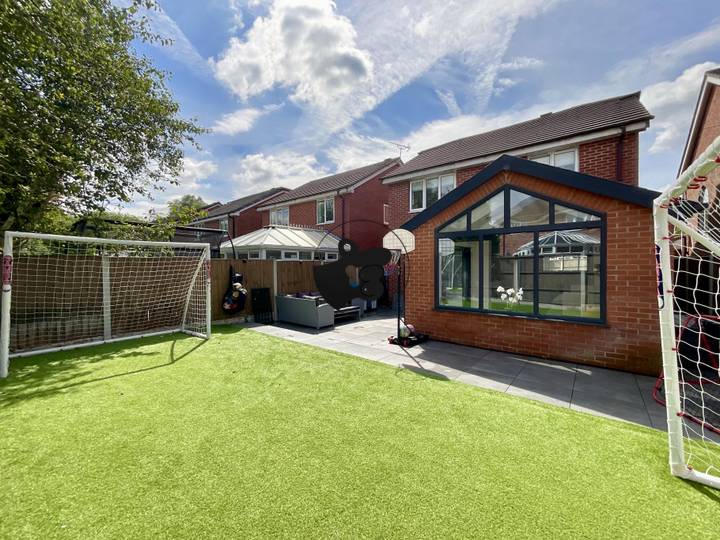Neighborhoods in St. Helens with the highest property values typically include areas such as Eccleston, where larger detached homes and attractive green spaces contribute to its desirability. The affluent area of Rainhill also stands out, known for its good schools and easy access to Liverpool, making it popular among families. Additionally, the affluent parts of Sutton and the picturesque village of Churchtown offer a mix of traditional and modern homes, further driving up property values. Lastly, locations around the town center, particularly those near amenities and transport links, can also command higher prices due to convenience and accessibility.
St. Helens
Location
Price Range
Any price
Price Range
Minimum
No min
Maximum
No max
Property type
Show all
Property type
Show all
House
Apartment
Building
Other
Bedrooms
Any beds
Bedrooms
Minimum
No min
Maximum
No max
Surface Range
Any surface
Surface Range
Minimum
No min
Maximum
No max
Sale type
For sale
Sale type
Show all
To rent
For sale
Location
Apartments and houses for sale in St. Helens
4 results
Recent
St. Helens insights
| Aspect | Summary |
|---|---|
| Population | Approximately 13,000 residents. |
| Average Property Price | Around £210,000. |
| Rental Yield | Approximately 5.5%. |
| Average Rent | Around £950 per month. |
| Occupancy Rate | Estimated at 92%. |
| Capital Growth Rate | Around 3-4% per annum. |
| Property Tax | Average council tax band is approximately £1,500 annually. |
| Transaction Costs | Roughly 3-5% of property price. |
| Expected ROI | Estimated at 8-10% over 5 years. |
| Economic Growth Impact | Moderate impact; local economy recovering post-pandemic. |
St. Helens FAQ
What neighborhoods in St. Helens have the highest property values?
What factors influence real estate prices in St. Helens?
Several factors influence real estate prices in St. Helens, UK. The location within the town plays a significant role; properties closer to amenities like schools, parks, and retail centers tend to command higher prices. For instance, areas near the town center or popular residential neighborhoods such as Eccleston often see increased demand. Economic conditions also impact the housing market; employment opportunities in nearby cities like Liverpool enhance the appeal of St. Helens for commuters, driving up real estate prices. Additionally, the condition and age of the property can affect pricing—newer homes or those recently renovated typically attract premium prices compared to older, less maintained properties. Local infrastructure developments, like improvements to transport links or the introduction of new services, can further influence the attractiveness of specific areas within St. Helens, thereby affecting property values. Finally, broader market trends, such as interest rates and government policies related to property ownership and taxation, also play a crucial role in shaping real estate prices in the region.
How have real estate prices in St. Helens changed over the last year?
Over the last year, real estate prices in St. Helens have experienced notable fluctuations, reflecting broader trends in the UK housing market. For instance, the average house price in St. Helens was reported to be around £200,000 in early 2023, which represented a slight increase from approximately £190,000 the previous year. This rise can be attributed to increased demand in the area, driven by its proximity to Liverpool and Manchester, appealing to both first-time buyers and investors. Specific property types have seen varied changes; semi-detached homes, for example, have been popular, with some properties selling for £220,000, while flats in the area have remained more affordable, with prices averaging around £130,000. Additionally, data indicates that there has been a growing interest in new developments, particularly family housing, further influencing the local market dynamics. The number of sales has also increased, leading to a competitive environment that has pushed up prices in certain neighborhoods such as Rainhill and Eccleston.
What is the average home price in St. Helens?
The average home price in St. Helens varies depending on the type of property and its location within the area. As of late 2023, the average price for residential properties in St. Helens is approximately £180,000. Semi-detached homes are commonly found in the region, with prices averaging around £200,000, while terraced houses can be more affordable, averaging close to £150,000. For example, a three-bedroom semi-detached house in a desirable neighborhood might sell for around £235,000, while smaller two-bedroom properties are often listed between £140,000 to £160,000. It's also notable that new developments in areas like the regeneration project around the town center may push prices slightly higher due to increased demand and modern amenities.
Are real estate prices in St. Helens expected to rise or fall?
Real estate prices in St. Helens are subject to a variety of influencing factors that could lead to either an increase or decrease. The town has seen an influx of investment in recent years, such as the development of new housing estates and the refurbishment of existing properties, which can drive up prices. For instance, areas like the popular Merton Bank have witnessed new developments that cater to families and first-time buyers, potentially elevating neighborhood desirability. In contrast, economic conditions, including rising interest rates and inflation, can dampen buyer confidence and exert downward pressure on prices. The local employment rate and the appeal of St. Helens as a commuter town also play crucial roles; a robust job market may attract more residents, while economic uncertainty could deter potential buyers. Additionally, the rental market's performance can impact property prices, as higher demand for rentals might lead to increased property purchases by investors, thereby influencing overall market trends.
How do local amenities affect real estate prices in St. Helens?
Local amenities significantly influence real estate prices in St. Helens. Proximity to schools is a major factor; families often prioritize homes near well-rated educational institutions, resulting in higher property demand in those areas. For example, neighborhoods close to St. Helens' excellent primary and secondary schools tend to see increased interest, pushing prices upward. Additionally, access to retail options, such as the St. Helens town center with its variety of shops and restaurants, can enhance desirability. Homes located near parks and recreational facilities like Sherdley Park also attract buyers looking for outdoor spaces, which can further elevate property values. Transport links, particularly those connecting St. Helens to larger cities like Liverpool and Manchester, also play a crucial role in real estate pricing; properties near train stations typically command higher prices due to the convenience of commuting.
How do school ratings impact real estate prices in St. Helens?
School ratings in St. Helens can significantly influence real estate prices, as many families prioritize access to quality education when selecting a home. Properties located in the catchment areas of well-rated schools often command higher prices because parents are willing to pay a premium for a strong educational environment. For example, homes near St. Cuthbert's Catholic High School, known for its good performance metrics and positive Ofsted ratings, can see increased demand, leading to higher offers. In contrast, areas served by lower-rated institutions may experience stagnant or declining property values, as prospective buyers may overlook these homes in favor of those in better school zones. This trend can create a disparity in neighborhoods within St. Helens, where similar homes in different school districts can vary by tens of thousands of pounds depending on the perceived quality of education available. Additionally, the rental market may reflect these trends, as landlords often adjust rent prices based on the local school ratings to attract families looking for a desirable educational experience for their children.





